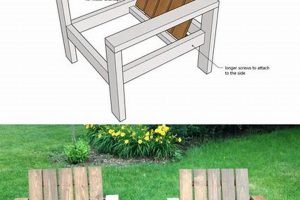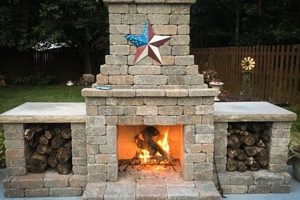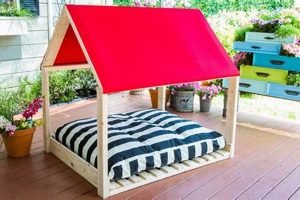The construction and adaptation of wooden shipping platforms for exterior applications represents a cost-effective and environmentally conscious approach to outdoor furnishing and design. These repurposed structures, commonly made of wood, can be disassembled, modified, and reassembled into a wide array of functional and aesthetic pieces. For example, a stack of these platforms can be transformed into raised garden beds, providing an elevated space for cultivating plants and vegetables.
Utilizing recycled resources in this manner offers several advantages. It reduces landfill waste by giving discarded materials a second life. Furthermore, it provides an economical alternative to purchasing new outdoor furniture or structures, making landscaping and outdoor design accessible to a wider range of individuals. The practice has gained traction as awareness of sustainable living and resource conservation has grown, reflecting a broader societal shift towards eco-friendly practices.
This approach encompasses a diverse range of possibilities, from simple seating arrangements to elaborate outdoor kitchens. Subsequent sections will detail various applications, material preparation techniques, and essential safety considerations for successfully undertaking such endeavors.
Essential Guidance for Pallet-Based Outdoor Creations
Adherence to specific guidelines ensures structural integrity and aesthetic appeal when repurposing shipping platforms for outdoor applications. Careful planning and execution are crucial for successful and safe projects.
Tip 1: Material Selection: Prioritize platforms designated as heat-treated (HT) rather than chemically treated (MB Methyl Bromide). This ensures the wood is safe for outdoor use, particularly in garden applications, and avoids potential contamination of soil or plants.
Tip 2: Structural Integrity: Thoroughly inspect each platform for damage such as cracks, splits, or rot. Damaged sections should be replaced or reinforced to maintain structural stability, especially in load-bearing applications like seating or tables.
Tip 3: Sanding and Surface Preparation: Sand all surfaces to remove splinters and rough edges. This process enhances both safety and the final aesthetic. Apply a suitable outdoor sealant or stain to protect the wood from weathering and moisture damage.
Tip 4: Proper Fasteners: Utilize exterior-grade screws or bolts designed for outdoor use. These fasteners resist corrosion and provide a secure connection between pallet components. Avoid nails, as they are prone to loosening over time due to expansion and contraction.
Tip 5: Design Considerations: Plan the project with consideration for weight distribution and stability. Reinforce joints and corners as needed, particularly for larger constructions. Ensure adequate drainage to prevent water accumulation and wood rot.
Tip 6: Weather Protection: Apply a water-resistant sealant or paint specifically formulated for outdoor wood. Regularly inspect and reapply as needed to maintain the protective barrier against the elements.
Tip 7: Compliance with Regulations: Verify local building codes and regulations regarding the construction of outdoor structures. Ensure that the project complies with all applicable safety standards and zoning requirements.
Diligent application of these guidelines ensures a durable, safe, and aesthetically pleasing outcome. Investing time in proper preparation and construction techniques enhances the longevity and functionality of the finished product.
The subsequent sections will address specific project ideas and demonstrate the practical application of these essential techniques.
1. Material Sourcing
The acquisition of wooden shipping platforms represents a foundational aspect of constructing exterior features. Responsible and informed selection directly impacts the safety, longevity, and environmental footprint of such projects.
- Pallet Classification
Shipping platforms are classified based on treatment methods, denoted by stamps indicating either heat treatment (HT) or chemical treatment (MB – Methyl Bromide). Prioritizing HT-stamped platforms is paramount. Methyl Bromide is a hazardous fumigant, and platforms treated with it should be avoided to prevent potential health risks. Heat treatment offers a safer alternative, ensuring the wood has been sterilized without the use of harmful chemicals.
- Structural Integrity Assessment
Thorough inspection is essential before utilizing any platform. Examine the wood for signs of decay, cracks, splits, or insect infestation. Compromised platforms can present structural weaknesses, leading to potential failure in the finished product. Rejecting or repurposing damaged materials for non-load-bearing components is a crucial safety measure.
- Supplier Reliability
Establishing relationships with reputable suppliers or businesses that regularly discard shipping platforms can provide a consistent source of materials. Direct communication allows for inquiries regarding the platform’s origin, treatment history, and previous use, mitigating the risk of acquiring contaminated or structurally unsound materials.
- Environmental Considerations
Choosing to reuse these materials inherently reduces landfill waste and lowers the demand for newly harvested timber. However, responsible sourcing also entails considering the environmental practices of the initial manufacturer or distributor. Opting for platforms from companies committed to sustainable forestry practices further minimizes the environmental impact.
Diligent attention to these factors during material procurement ensures the construction of safer, more durable, and environmentally responsible outdoor features. The selection process is not merely about acquiring free or inexpensive resources but about making informed decisions that align with safety standards and ecological responsibility. Further investigation into wood types and potential contaminants remains prudent.
2. Design Planning
Design planning constitutes a critical preliminary phase in the successful execution of exterior constructions. This process involves a comprehensive evaluation of intended functionality, spatial constraints, material requirements, and aesthetic considerations, directly influencing the structural integrity, usability, and visual appeal of the finished project.
- Functional Requirements Definition
This aspect involves a detailed assessment of the intended purpose of the structure. For instance, if the project involves constructing outdoor seating, the design must account for the expected load-bearing capacity, ergonomic considerations, and anticipated usage patterns. Defining functional requirements informs material selection, structural design, and overall dimensions. Neglecting this stage can result in a structure that is ill-suited for its intended use, compromising both safety and functionality.
- Spatial Integration and Layout Optimization
Design planning necessitates a careful consideration of the available space and its relationship to the surrounding environment. This includes measuring dimensions, assessing sunlight exposure, and accounting for existing landscaping features. Optimizing the layout ensures that the structure complements the site and maximizes its usability. For example, a raised garden bed constructed from shipping platforms should be positioned to receive adequate sunlight and facilitate easy access for maintenance. Inadequate spatial planning can lead to obstructions, inefficient use of space, and aesthetic disharmony.
- Material Calculation and Resource Allocation
Accurate estimation of material quantities is crucial for cost control and project efficiency. Design planning should include a detailed inventory of required resources, including the number of shipping platforms, fasteners, sealants, and other necessary components. Proper material calculation minimizes waste, reduces the likelihood of project delays, and ensures that sufficient resources are available throughout the construction process. Furthermore, planning should consider the potential for repurposing materials and minimizing environmental impact through responsible resource allocation.
- Aesthetic Integration and Visual Harmony
Beyond functionality, aesthetic integration plays a significant role in the overall success of any project. Design planning should address the visual appearance of the structure, considering factors such as color schemes, surface treatments, and overall design style. The goal is to create a structure that complements the existing aesthetic of the outdoor space and enhances its visual appeal. For example, the style and finish of an outdoor bar constructed from shipping platforms should harmonize with the surrounding landscape and architectural elements. Neglecting aesthetic considerations can result in a structure that appears out of place or detracts from the overall beauty of the outdoor environment.
In conclusion, design planning is an indispensable element of any successful project. By meticulously addressing functional requirements, spatial integration, material allocation, and aesthetic integration, individuals can ensure that their creations are not only structurally sound and functional but also visually appealing and environmentally responsible. Omission of this stage inevitably compromises the overall quality and sustainability of the finished structure.
3. Structural Integrity
The capacity of a structure to withstand applied loads without failure is termed structural integrity. Within the context of constructing outdoor features from repurposed shipping platforms, this aspect assumes paramount importance. Shipping platforms, initially designed for one-time or limited-use scenarios, may exhibit inherent weaknesses or degradation accumulated during prior service. Consequently, their suitability for conversion into load-bearing elements within furniture, raised gardens, or outdoor kitchens requires rigorous evaluation and often, reinforcement. A failure to adequately address structural integrity can precipitate collapse, resulting in property damage or personal injury. For example, a seating arrangement crafted from degraded platforms could buckle under the weight of occupants, posing a significant safety hazard.
Assessment involves meticulous inspection for signs of rot, insect damage, cracks, or loose joints. Prioritizing platforms exhibiting minimal degradation is crucial, followed by the implementation of reinforcing measures such as additional support beams, robust fastening systems, and load distribution strategies. Utilizing exterior-grade fasteners designed to resist corrosion and shear forces is also essential. In applications demanding significant load-bearing capacity, the addition of supplementary structural elements fabricated from new lumber or metal may be necessary to ensure adequate strength and stability. Consider a raised garden bed; the weight of the soil, particularly when saturated with water, exerts considerable pressure on the platform structure. Reinforcing the frame with additional bracing prevents bowing and potential collapse.
Maintaining structural integrity in such endeavors presents ongoing challenges due to the inherent variability in the condition of reclaimed materials and the exposure to environmental stressors. Regular inspection and maintenance are crucial for identifying and rectifying any signs of weakening or deterioration. The long-term success and safety depend on integrating sound engineering principles, meticulous material selection, and consistent monitoring, reinforcing the necessity for a rigorous approach to structural evaluation when working with recycled shipping platforms in outdoor applications.
4. Surface Treatment
Surface treatment constitutes a crucial phase in the lifecycle of structures crafted from repurposed shipping platforms. The application of appropriate coatings and treatments significantly enhances the longevity, aesthetic appeal, and resistance to environmental degradation of these projects.
- Protection Against Moisture Ingress
Wooden shipping platforms, when exposed to the elements, are susceptible to moisture absorption, leading to rot, fungal growth, and structural weakening. The application of water-resistant sealants or paints creates a protective barrier, preventing water from penetrating the wood fibers. This is particularly important for outdoor furniture or raised garden beds that are in direct contact with the ground or exposed to frequent rainfall. For instance, applying a polyurethane sealant to a pallet-based coffee table effectively mitigates water damage from spills and inclement weather, extending its lifespan.
- Mitigation of Ultraviolet (UV) Degradation
Prolonged exposure to ultraviolet radiation from sunlight causes the lignin in wood to break down, resulting in discoloration, surface cracking, and reduced structural integrity. Applying UV-resistant stains or paints shields the wood from these harmful effects. This is especially relevant for structures that are continuously exposed to direct sunlight, such as outdoor benches or planters. For example, using a stain with UV inhibitors on a pallet-based sun lounger preserves its color and prevents surface damage, maintaining its aesthetic appeal and structural soundness.
- Enhancement of Aesthetic Appeal
Surface treatments offer an opportunity to customize the appearance of creations, aligning them with individual preferences and the surrounding environment. Staining, painting, or applying decorative finishes can transform the appearance of a repurposed shipping platform, creating a polished and aesthetically pleasing final product. A coat of vibrant paint transforms a plain pallet into a colorful and attractive swing. Surface treatment enhances the visual integration with its surrounding and extends the project’s life.
- Prevention of Pest Infestation
Untreated wood is vulnerable to insect infestation, which can compromise structural integrity. Applying wood preservatives containing insecticides helps to deter pests and protect the wood from damage. This is particularly important in regions with high termite or carpenter ant activity. The application of a borate-based wood preservative on a pallet structure effectively prevents wood-boring insects from establishing colonies, safeguarding it from structural damage and ensuring its longevity.
The selection and application of appropriate surface treatments are essential for maximizing the durability, visual appeal, and long-term performance of any project involving repurposed shipping platforms. Such treatments provide protection against moisture, ultraviolet radiation, pests, and other environmental factors, ensuring that these creations remain functional and aesthetically pleasing for years to come.
5. Weather Resistance
The propensity of materials to withstand environmental conditions without degradation is termed weather resistance. In the context of constructing outdoor features, achieving adequate weather resistance is paramount for ensuring longevity and structural integrity. Repurposed shipping platforms are inherently susceptible to damage from moisture, ultraviolet radiation, temperature fluctuations, and biological organisms. Consequently, the design and construction processes must incorporate strategies to mitigate these effects.
The absence of effective weatherproofing measures invariably leads to deterioration, rendering the structures unsafe and aesthetically unappealing. Consider a raised garden bed constructed from untreated shipping platforms; prolonged exposure to rainfall and soil moisture promotes fungal growth and wood rot, compromising the structural integrity of the frame and potentially contaminating the soil. Similarly, outdoor furniture left unprotected against sunlight exhibits surface cracking, discoloration, and weakening of the wood fibers over time. Selecting appropriate materials, such as pressure-treated lumber or naturally weather-resistant wood species, constitutes a fundamental step. Furthermore, applying protective coatings, including sealants, paints, or stains, provides an additional layer of defense against the elements. Regular maintenance, such as periodic reapplication of sealants and prompt repair of any damage, is essential for preserving weather resistance over the long term.
In conclusion, weather resistance represents a critical determinant of the success and sustainability of any project. Neglecting this factor invariably results in premature failure and necessitates costly repairs or replacements. A proactive approach to weatherproofing, encompassing careful material selection, appropriate surface treatments, and diligent maintenance, extends the lifespan of these creations, ensuring their continued functionality and aesthetic appeal. The practical understanding and implementation of weather-resistant strategies are essential for maximizing the value and minimizing the environmental impact of repurposing shipping platforms for outdoor applications.
6. Safety Measures
The integration of safety measures is inextricably linked to the successful execution of outdoor features from repurposed shipping platforms. The inherent nature of these projects, often involving reclaimed materials and modifications to structural components, necessitates a proactive approach to identifying and mitigating potential hazards. Neglecting safety considerations elevates the risk of accidents, injuries, and structural failures, undermining the overall viability and sustainability of the endeavor. For instance, improper handling of power tools during the disassembly or modification of shipping platforms can lead to cuts, lacerations, or electrocution. The absence of adequate personal protective equipment (PPE), such as safety glasses and gloves, further exacerbates the risk of injury. Similarly, failure to properly secure structural connections or reinforce weakened areas can result in collapses, posing a significant threat to individuals utilizing or interacting with the finished product.
A comprehensive safety strategy encompasses several key elements. Firstly, a thorough risk assessment should be conducted prior to commencing any project, identifying potential hazards associated with material handling, tool usage, structural modifications, and environmental factors. Secondly, strict adherence to established safety protocols is essential. This includes utilizing appropriate PPE, ensuring proper tool maintenance and operation, and implementing safe work practices. Furthermore, projects involving electrical components or structural modifications should be undertaken by individuals with the necessary skills and expertise. Consider the construction of a raised garden bed from reclaimed platforms: improper handling of the platform during assembly could result in back injuries, and failure to adequately secure the structural frame could lead to collapse under the weight of soil. Similarly, if incorporating lighting, electrical wiring must be installed by a qualified electrician to prevent shock hazards.
In summation, the implementation of rigorous safety measures represents an indispensable aspect. A proactive and comprehensive safety plan not only minimizes the risk of accidents and injuries but also contributes to the long-term durability and functionality of these features. Integrating safety into every stage of the project, from initial planning to final construction, safeguards the well-being of individuals and promotes the responsible and sustainable utilization of repurposed materials. Ultimately, safety measures transform such project concepts into a safer reality.
7. Code Compliance
Adherence to local building codes and regulations represents a critical, yet often overlooked, aspect of constructing exterior features from repurposed shipping platforms. Compliance ensures the safety, structural integrity, and legal permissibility of such projects. Failure to meet established codes can result in fines, mandated alterations, or even demolition, thereby negating the economic and environmental benefits of utilizing recycled materials.
- Zoning Regulations and Permitting Requirements
Many municipalities have zoning regulations that dictate permissible land use, setback distances, and structure height. Erecting a structure, even one utilizing recycled materials, that violates these regulations can lead to legal repercussions. Furthermore, depending on the size and nature of the project, a building permit may be required prior to commencement. For example, constructing a large outdoor kitchen from shipping platforms may necessitate a permit to ensure compliance with fire safety standards and structural load-bearing requirements. Failure to obtain the necessary permits can result in costly delays and legal penalties. A thorough check with the local municipality to determine zoning restrictions and permitting requirements is essential prior to initiating any building project.
- Structural Safety Standards
Building codes establish minimum standards for structural safety to protect occupants and prevent collapses. These standards address aspects such as load-bearing capacity, wind resistance, and seismic stability. When repurposing shipping platforms, it is crucial to ensure that the structure meets these requirements. For instance, a deck constructed from shipping platforms must be able to support the anticipated load without deflection or failure. Reinforcing the structure with additional support beams, using appropriate fastening systems, and adhering to span limitations can help ensure compliance with structural safety standards. Consultation with a structural engineer may be advisable for complex or load-bearing structures.
- Fire Safety Regulations
Fire safety codes are designed to minimize the risk of fire hazards and ensure the safe egress of occupants in the event of a fire. When incorporating wood into outdoor structures, especially near potential ignition sources such as grills or fire pits, it is essential to comply with fire safety regulations. This may involve applying fire-retardant coatings to the wood, maintaining appropriate clearances from combustible materials, and installing smoke detectors. For instance, constructing an outdoor bar from shipping platforms near a grill may necessitate the application of a fire-retardant sealant to the wood surfaces to reduce the risk of fire ignition. Understanding local fire safety regulations and implementing appropriate preventative measures is critical for protecting lives and property.
- Electrical and Plumbing Codes
If a project involves electrical wiring or plumbing, compliance with relevant codes is imperative. Electrical codes dictate safe wiring practices, grounding requirements, and the use of approved materials. Plumbing codes regulate the installation of water lines, drainage systems, and backflow prevention devices. When constructing an outdoor kitchen with a sink and electrical outlets, it is essential to ensure that the wiring and plumbing are installed by qualified professionals and comply with all applicable codes. Failure to adhere to electrical and plumbing codes can result in electrical shocks, water leaks, and other hazards.
In summary, adhering to applicable building codes and regulations is paramount for ensuring the safety, legality, and long-term viability. Seeking guidance from local building officials, structural engineers, and qualified tradespeople can help navigate the complexities of code compliance and ensure that such project align with established standards.
Frequently Asked Questions
The following addresses recurring inquiries concerning the construction of outdoor features from reclaimed shipping platforms. It offers guidance on common challenges and misconceptions.
Question 1: What constitutes a safe material for repurposing into garden beds?
Shipping platforms designated with “HT” (heat treated) are generally considered safer than those marked “MB” (methyl bromide), a hazardous fumigant. However, any platform’s prior use should be considered; avoid platforms that may have transported toxic materials.
Question 2: How can structural integrity of reclaimed platform be assessed?
Inspect each platform thoroughly for cracks, splits, rot, and loose joints. Discard or reinforce any compromised sections. Pay particular attention to areas where fasteners are located, as these are common points of failure.
Question 3: What type of sealant should be used for weatherproofing outdoor constructions?
Employ sealants specifically formulated for exterior wood applications. These products offer protection against moisture, ultraviolet radiation, and temperature fluctuations. Reapply sealants periodically to maintain optimal performance.
Question 4: Are specific fasteners recommended for exterior assemblies?
Exterior-grade screws or bolts, designed to resist corrosion, are preferable to nails. Screws and bolts provide a stronger and more durable connection, particularly in load-bearing applications.
Question 5: Is it necessary to sand before surface treatment?
Sanding the platform surface is highly recommended to remove splinters and create a smoother finish. This improves both safety and the adherence of sealants or paints.
Question 6: How is compliance with local regulations ensured?
Contact the local building department to inquire about zoning regulations and permitting requirements. Ensure the construction adheres to all applicable codes related to structural safety, fire safety, and electrical installations.
These inquiries serve as a foundational understanding. It emphasizes the importance of due diligence, sound construction practices, and code compliance.
The following section explores specific designs for outdoor spaces.
Concluding Remarks on DIY Outdoor Pallet Projects
The preceding exploration of “diy outdoor pallet projects” has illuminated crucial aspects from material sourcing and structural integrity to weather resistance and code compliance. Safe and sustainable project execution demands rigorous attention to detail, informed decision-making, and adherence to established standards. The inherent variability in reclaimed materials necessitates thorough inspection and proactive reinforcement to ensure structural soundness. Additionally, surface treatments, weatherproofing measures, and compliance with local regulations are paramount for longevity, safety, and legal permissibility.
Ultimately, the success of constructing outdoor features hinges on a commitment to responsible practices and meticulous execution. The information presented serves as a foundation for informed engagement, promoting resourcefulness and safety. Continued education and adherence to best practices are essential for maximizing the potential and minimizing the risks associated with such endeavors.







